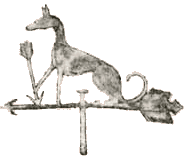|
 |
 |
 |
 |
 |
 |
 |
 |
 |
 |
 |
 |
 |
|
 |
RADIO SECURITY SERVICE
|
|
 |
 |
|
|
|
|
|
|
|
|
|
|
 |
Hanslope Park - An Historical Background
Created by the early manorial family, the Maudits, following the Conquest a hunting park was established at Hanslope and by Royal agreement several stags were taken from Salcey Forest to fortify the stock. Eventually this was acquired by Basil Brent, by whom in the late seventeenth century the present mansion was built. In time William Watts, an ex governor of Bengal, in June, 1764, bought possession and his tomb may be seen in the local church. Whilst in India, William had been attacked by a rabid dog and he was only saved from a severe mauling, or worse, by the action of a bystander, who fired an arrow through the animal's paw. |
|
|
 |
As a sign of his gratitude William had the representation of a hound with an arrow through the paw incorporated in the family coat of arms and on the top of Hanslope church spire the weathervane is shaped in a similar depiction! |
|
|
 |
 |
|
|
|
|
|
|
|
 |
|
 |
|
|
|
 |
|
The 180 ft. spire is sur-mounted by an unusually shaped weathervane!
|
|
|
|
 |
|
Hanslope church |
|
|
|
|
|
|
 |
In 1853 the Hanslope estate descended to Edward Watts who thereby succeeded to the Hanslope mansion.
Then the building stood as an imposing rectangular house with a spacious square hall, the ceiling supported by substantial pillars. From the hall six doorways led to the porch, front staircase, dining room, library, drawing room and back area.
The kitchens were situated below ground level with underground passages giving access to the servants hall, dairy, knife room, boot room, coal cellars and pantry. A ghostly green lady is said to wander these passages whilst a phantom coach is supposed to pull up on the wide sweep, before the main entrance. It is always heard but never seen. The house had a home farm and surrounded by high walls, a kitchen garden, almost an acre in extent. In the potting shed a butler is said to have hanged himself from the rafters. |
|
|
 |
At the age of 23 Edward Watts married Sophia Edith, one of the 'Eight Belles' Selby Lowndes daughters from 'Elmers', in Bletchley and as brother in law of the lady of the manor Sir John French, of military fame, (later the 1st. Earl Ypres), often came to stay at the Hanslope mansion. After the marriage of Irene, their daughter, Sophia Edith and Edward Watts should have settled into a genteel role as country squire and lady but tragic and sensational events were unfortunately to follow. On Sunday July 21st., 1912, as they were quietly strolling home from church, two gunshots suddenly rang out and the squire fell dead. Within a moment a third shot echoed from a roadside spinney as the gunman, William Farrow, the head gamekeeper, took his own life. Sophia never recovered from her husband's death. Often she would wander alone to the scene of the murder and by arrangement with the County Council she caused the road to be diverted away from this fateful place. Nevertheless, Edith continued to |
|
 |
|
|
 |
conduct estate affairs until her death in 1930, when her daughter and son in law came to live at Hanslope. Mark died the following year and Irene made over the estate to her son Robin, who - as decreed by terms of the will - assumed the additional surname of Watts. Against rising financial costs, Robin maintained the estate until 1939, when a sale was made to Lord Hesketh, of Easton Neston. The Government then acquired the tenancy at the outbreak of the war and have remained ever since. |
|
|
 |
|
|
|
Back to top |
|
|
|
|
|
|
|


